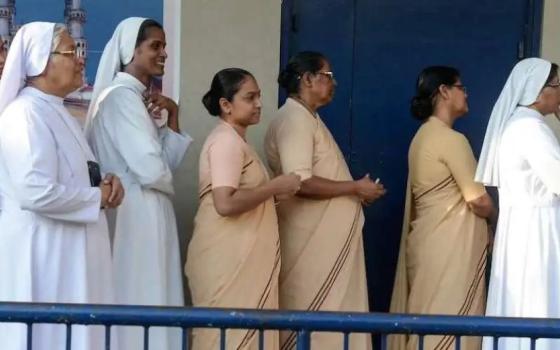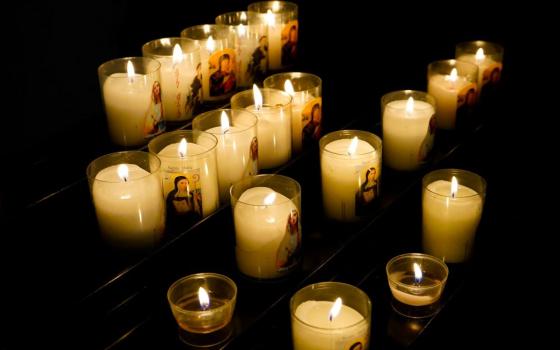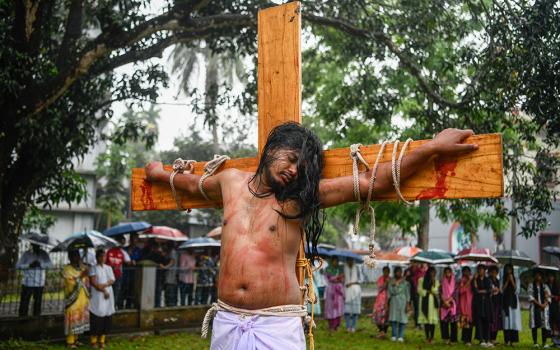A group of novices and aspirants chat after lunch in the refectory of the motherhouse of the Missionary Sisters of the Eucharist in San Andres Semetabaj, Guatemala, Aug. 22, 2023. The congregation, which works with older adults, has flourished among Indigenous communities in western Guatemala. (GSR photo/Rhina Guidos)
Sr. Marta Yach Cosme walked through of one the gardens of motherhouse of the Missionary Sisters of the Eucharist, touching the fronds of the ubiquitous plants and squeezing the herbs with the tips of her fingers, explaining their medicinal purposes.
"We have to have that knowledge of medicinal plants because we go to very distant areas where you can't get a doctor. So, [we figure out] how to help those who are sick whom we find in our pastoral work," Yach explained about her congregation's ministry in the highlands of western Guatemala.
For many reasons, including war, discrimination against Indigenous people, poverty, and an accident, it's almost a miracle that Yach is there at all, walking among the congregation's beloved gardens. She certainly never saw herself that way, growing up as an Indigenous woman in nearby Panajachel.
Yet God makes great things happen, said Yach, now the leader of a congregation of 49 Indigenous sisters, founded almost 50 years ago in the middle of her country's civil conflict.
The Missionary Sisters of the Eucharist didn't just survive the violence of the Lake Atitlán region back then, but they flourished during the war's 36 years and now have missions in San Pedro Ayampuc; Tamahu; Cobán; Santiago Atitlán in Sololá; Tecpán in Chimaltenango; Joyaba and Santa Cruz in El Quiché; and San Andrés Semetabaj.
Inspired by the Second Vatican Council, an American missionary, Sr. Tonia Orland, started a congregation of Indigenous nuns in Guatemala that today has 49 members: the Missionary Sisters of the Eucharist
Sr. Angelina Chex, right, talks with Mother Marta Yach Cosme, in the garden of the motherhouse of the Missionary Sisters of the Eucharist in San Andres Semetabaj, Guatemala, Aug. 22, 2023. The community of 49 sisters working in Indigenous communities was founded by U.S. Sr. Tonia Orland of the Sisters of the Presentation of the Blessed Virgin Mary. (GSR photo/Rhina Guidos)
But when they were founded in 1975 by Sr. Tonia Maria Orland, of the U.S.-based Sisters of the Presentation of the Blessed Virgin Mary, Orland had a hard time convincing Indigenous women like Yach that consecrated life was for them.
"My parents said nuns came from families of ... economic means and they have to have a high academic degree. So, what chance did I have of becoming a woman religious?" Yach told Global Sisters Report.
Besides facing deep-seated racism in Guatemalan society, members of Indigenous groups like Yach also faced uphill battles to obtain an education, which required money, and it was questionable whether congregations would even accept an Indigenous vocation.
So, even though she admired and longed to be like the women dedicated to the poor and to God she saw in the streets of her hometown of Panajachel, she didn't think it was an option. Neither did Sr. Angelina Chex, now vicar general of the community, or Sr. Petronila Coquix, who also makes up part of the congregation's council.
But today, they are in charge of the Missionary Sisters of the Eucharist, one of three congregations of Indigenous women religious in Guatemala, which was founded by Orland, the Presentation Sister from the U.S. Orland died in 2000, and is known affectionately in the area as "Madre Tonia."
When Orland arrived in the region in the early 1970s, the lush landscapes and volcanoes surrounding towns and villages like Panajachel were theaters of violence and widespread discrimination, particularly against poverty-stricken Indigenous communities. Yet, deep inside those perilous places, Orland and others stepped in to help, and many lost their lives doing so, including Oklahoma's Blessed Stanley Rother, a U.S. priest who served the Tz'utujil Indigenous community in the Lake Atitlán area from 1968 until he was martyred in 1981.
Advertisement
Orland, too, received death threats and went into hiding. But not a lot deterred her. She dressed much like most of the women in town, wearing what they call a traje, a colorful woven outfit Indigenous women wear, Yach recalled.
She began instituting a daily routine focused on the Blessed Sacrament "to have the strength of our Lord" so the sisters could help the nearby villages, Chex said.
That spiritual strength helps sisters as they go out physically into treacherous territory, which in Orland's time meant armed groups firing at one another. But even in times of relative peace, sisters step into untamed wilderness, taking the Gospel to places devoid of transportation.
Yach bears large scars on both arms from an accident she suffered during one of those journeys, when she was caught by a mudslide. She broke her arms as she grabbed the roots of a tree that came tumbling and dragged her. It was hard to breathe under the mud, she calmly recalled.
But God must still have a mission for her because a group of people pulled her out, she told GSR.
Missionary Sisters of the Eucharist approach communities with the Gospel, but were taught to also be respectful of the variety of beliefs among Indigenous groups, Yach said. Orland not only sought to promote education in general, but also to have the sisters get to know the communities of the area to serve them.
"Madre Tonia gave us an integral formation as Indigenous people," Yach said.
Once a year, the sisters celebrate a day of culture, when each one can wear, instead of the congregation's own traje, the Indigenous traje that identifies her with her ancestral community.
Sr. Juana Toma Perez shows Sr. Marta Yach Cosme an ointment made from natural ingredients at a store run by the Missionary Sisters of the Eucharist in San Andres Semetabaj, Guatemala, Aug. 22, 2023. Some sisters have knowledge of the medicinal benefits of plants or massage as alternative medicine, which helps them serve the Indigenous peoples of the region. (GSR photo/Rhina Guidos)
Sisters receive traditional education and formation as women religious, but they also learn about the beliefs, customs, languages and practices of the different Mayan communities in the region. Their focus on the Eucharist also calls them to care for the elderly and youth with few resources, Coquix said.
They have knowledge of the different languages of the region, such as Kaqchikel, K'iche' and Tz'utujil, as well as of each culture, its customs and religious beliefs.
The motherhouse in San Andrés Semetabaj, a short distance from Panajachel, is decorated with words and images of the sisters' dominant cultures: that of Indigenous Guatemalan communities and Christianity. Their chapel has a tabernacle with the word "AJAW," which translates to "Lord"; a decoration of St. Kateri Tekakwitha, the first American Indian saint of the Catholic Church; and a poster of the traditional clothing of Indigenous groups in Guatemala.
Along with knowledge of the medicinal benefits of plants, some sisters also have knowledge of massage as alternative medicine, something popular in the remote places where they go on mission.
"Our work is to go to rural areas, to go to those who suffer," Yach said.
Indigenous communities see that the sisters look like them, talk like them but also dress like them.
'When we go to the villages, we speak in our languages to the elders who don't speak much Spanish ... and the people feel confident. I believe that because of that, they also feel valued.'
—Sr. Petronila Coquix
Sr. Angelina Chex, vicar general of Missionary Sisters of the Eucharist in San Andres Semetabaj, Guatemala spoke Aug. 22, 2023, about the influence of Sr. Tonia Maria Orland, of the Sisters of the Presentation of the Blessed Virgin Mary, who founded their congregation. Madre Tonia, as she was known, promoted vocations to religious life among the Indigenous communities of Guatemala. (GSR photo/Rhina Guidos)
"When we go to the villages, we speak in our languages to the elders who don't speak much Spanish ... and the people feel confident," said Coquix. "I believe that because of that, they also feel valued."
In the past, each sister wore her own huipil, an embroidered blouse that identified her as part of a specific community. However, when Orland found out that some blouses and outfits were more expensive than others, she decided that all the sisters would retain Indigenous dress but would wear the congregation's own type of traje. The sisters now don a blue, purple and black habit with pinkish tones that looks like no other type of Indigenous dress in the region and now is associated with the congregation.
Once a year, however, the sisters celebrate a day of culture, when each one can wear, instead of the congregation's dress, the Indigenous traje that identifies her with her ancestral community. They also share their typical food, and the customs and traditions they grew up with.
"Most people look up to us," Yach said. "But there are also some who don't. Madre Tonia gave value to our culture."
Conveying to others the value of Indigenous people has taken time, Yach said. Orland arrived in Guatemala in a propitious moment in the Guatemalan church, which was then seeking to increase vocations among Indigenous communities that had been largely marginalized.
"For the church, it has not been easy," Yach said. "But some bishops support these Indigenous foundations and value them highly."
'My parents said nuns came from families of ... economic means and they have to have a high academic degree. So, what chance did I have of becoming a woman religious?'
—Sr. Marta Yach Cosme
On Aug. 22, 2023, novice Angelica Alvarado, left, and Mother Marta Yach Cosme stand by the tomb of Sr. Tonia Maria Orland, foundress of the congregation Missionary Sisters of the Eucharist. Orland, of the Sisters of the Presentation of the Blessed Virgin Mary, promoted vocations among Indigenous people in Guatemala. (GSR photo/Rhina Guidos)
Some sisters in the congregation have studied psychology or theology, and obtained degrees to allow them to serve as teachers, nurses, secretaries and social workers — all with the purpose of helping the poor communities in their surroundings.
Because of the link with Orland, they have been able to count on the closeness of the Presentation Sisters, whom they call "aunts" and who, with the help of the Hilton Foundation (which also funds GSR), have helped them to provide psychological and educational services for young people in the region, something that they say has helped them to grow.
To help with community expenses, the sisters make hosts, sell medicinal plants from their nursery and also operate the "Madre Tonia Store" where they sell religious articles, as well as natural medicinal ointments and oils that the sisters have created.
"Madre Tonia said that the Holy Spirit touched her heart, seeing the need in our country, but she never thought of founding a congregation like what we are right now," Yach said.
As she was dying, Orland made one final connection for the sisters in Houston, where she was receiving chemotherapy. An organization asked for help caring for the elderly. As a result, the sisters have a mission in Texas.
Orland's biological family as well as her religious congregation allowed her body to return to Guatemala, saying she belonged to them. She is buried in the chapel at the motherhouse, and Yach said many young people stop by the tomb to ask for her intercession during their migration journey.
"We are convinced that God inspired Madre Tonia," said Chex, the vicar. "Madre Tonia is still with us."
Editor's note: This article was originally published in Spanish.






